Ethereum Faces Critical Support: Can the $2,800 Level Hold?
Current Price Review and Market Context

Chart: https://www.gate.com/trade/ETH_USDT
ETH has recently traded in a volatile range around $2,800, drawing intense focus from market participants. In recent sessions, buyers and sellers have battled for dominance at this level, making it the focal point of current market activity. On-chain and technical analysis both identify this zone as a key support area, which also aligns with the “realized price”—a critical metric reflecting the true average cost for holders. Historically, when ETH approaches this range, market sentiment tends to reverse in the short term. Whether ETH can hold above $2,800 will play a decisive role in shaping its next move.
Why Is $2,800 a Critical Support Level?
Technically, $2,800 stands out as a historically robust support zone, having served as the base for major bottoms multiple times. Across multiple timeframes, this range benefits from support from trendlines, heavy trading volume, and long-term moving averages—creating a confluence of support levels. On-chain data shows most ETH holders have an average cost basis in this zone. If ETH remains below this level, investors may become more reluctant to realize losses, which could fuel further selling pressure. Conversely, holding above $2,800 may trigger a short-term rebound.
Large “whale” addresses are steadily accumulating at this level, while smaller holders are reducing their exposure. This pattern signals a redistribution of tokens: weaker hands are exiting and stronger hands are accumulating, potentially signaling a trend reversal. As a result, many traders see this area as a potential “bottoming zone.”
What Are On-Chain and Technical Indicators Revealing?
Recent on-chain data indicates sustained buying support for ETH near $2,872, suggesting continued market willingness to absorb supply at these levels. From a technical pattern perspective, ETH has formed an “inverse head and shoulders” pattern. A breakout above the neckline could unleash renewed bullish momentum and offer a pathway to higher price targets. When combined with Fibonacci levels and the realized price distribution, these factors suggest that support is strong. If support holds, ETH could stage a short-term rebound.
Nevertheless, ETH’s trajectory is not dictated solely by technical or on-chain metrics—macroeconomic conditions remain highly influential. US employment reports, shifts in interest rate expectations, and overall risk sentiment across asset classes can quickly disrupt the current equilibrium.
What Are the Risks If Support Breaks?
If ETH drops below $2,800 with rising volume, it may trigger a cascading decline. Analysts warn that tightened liquidity, major capital outflows, or mass liquidations of leveraged positions could intensify selling and push ETH to lower levels.
Key technical zones are often marked by sharp volatility, so short-term traders should be especially vigilant about the directional risks associated with rapid breakdowns. During this phase, most investors should focus on disciplined risk management instead of trying to anticipate the next price movement.
Investor Strategies at Key Levels
When approaching critical price zones, investors should remain composed and make strategic decisions, considering the following:
- Monitor whether ETH can maintain support above $2,800 and close consistently at or above this level to confirm the validity of support;
- If ETH breaks key resistance or rallies with strong volume, treat this as a signal to watch, but avoid chasing momentum blindly;
- If ETH demonstrates weakness or breaches key support, avoid increasing leverage or shorting aggressively to sidestep potential bull or bear traps;
- Implement staggered entry strategies to reduce risk. Use stop-loss orders to protect against losses from concentrated positions;
- Track macroeconomic indicators—such as employment data, interest rate trends, and dollar index fluctuations—as these often determine the direction of risk assets.
Conclusion
In summary, $2,800 is more than a technical support level for ETH—it represents a crossroads for capital flows and market sentiment. If ETH holds this range, it could build a strong foundation for a rebound and a potential interim bottom. However, if support fails, investors should remain alert to the risks and uncertainties of further declines. Patience, discipline, and a sound strategy that matches each investor’s risk tolerance are essential for navigating this phase.
Related Articles

Pi Coin Transaction Guide: How to Transfer to Gate.io

Flare Crypto Explained: What Is Flare Network and Why It Matters in 2025

How to Use a Crypto Whale Tracker: Top Tool Recommendation for 2025 to Follow Whale Moves

2025 BTC Price Prediction: BTC Trend Forecast Based on Technical and Macroeconomic Data

What is N2: An AI-Driven Layer 2 Solution
